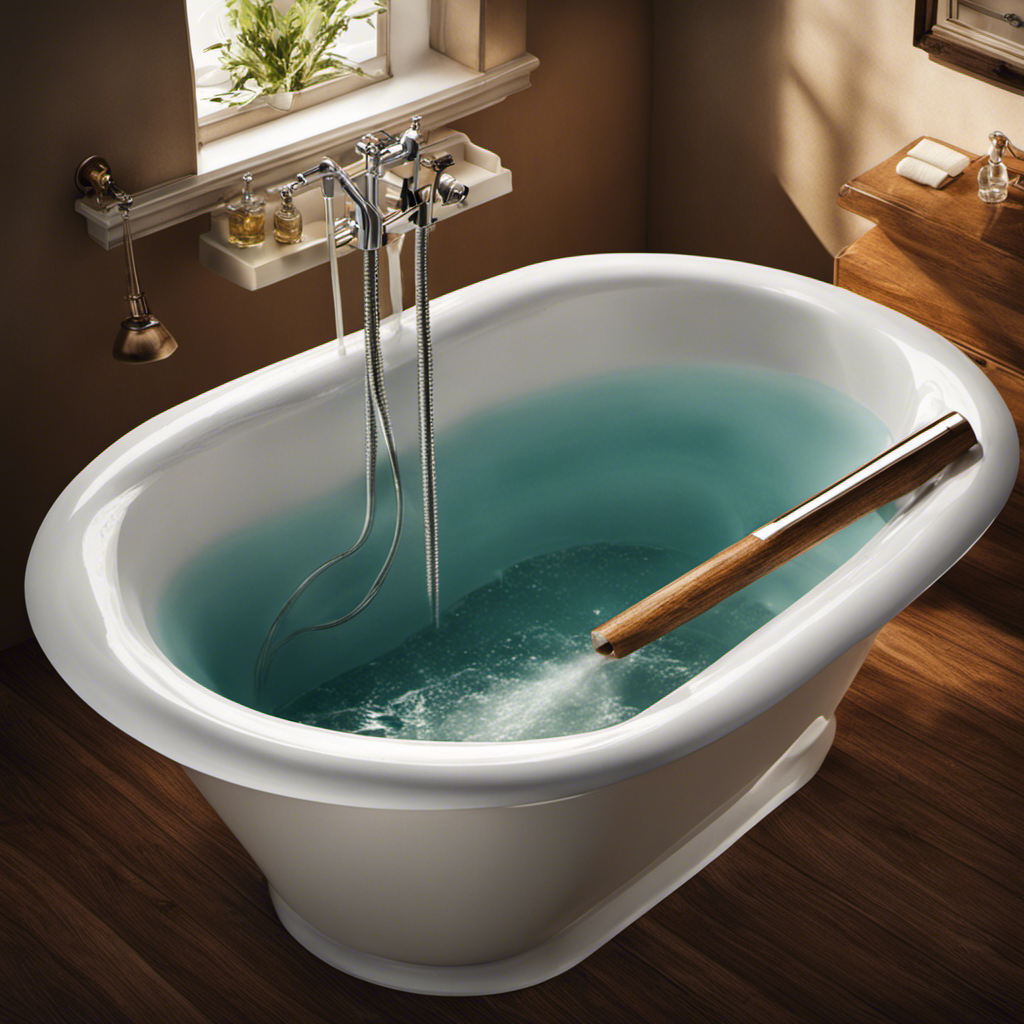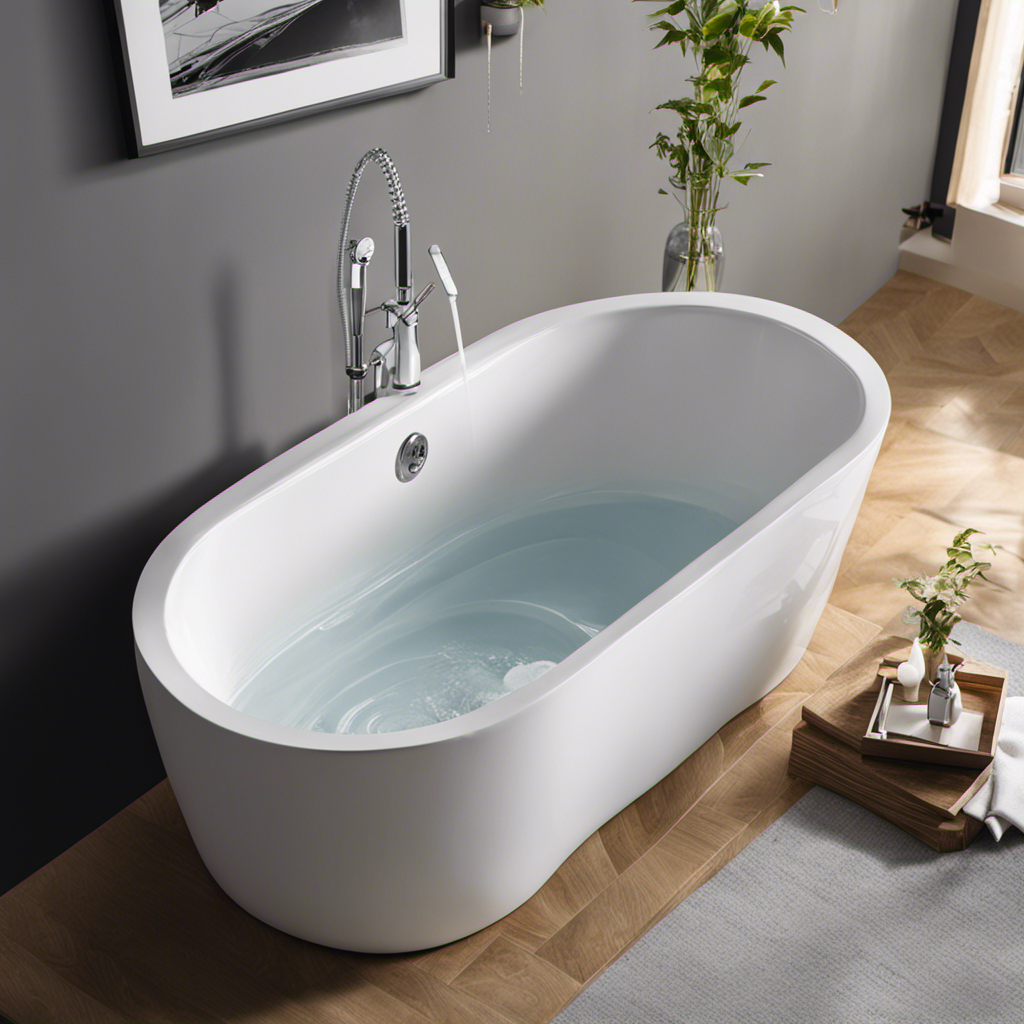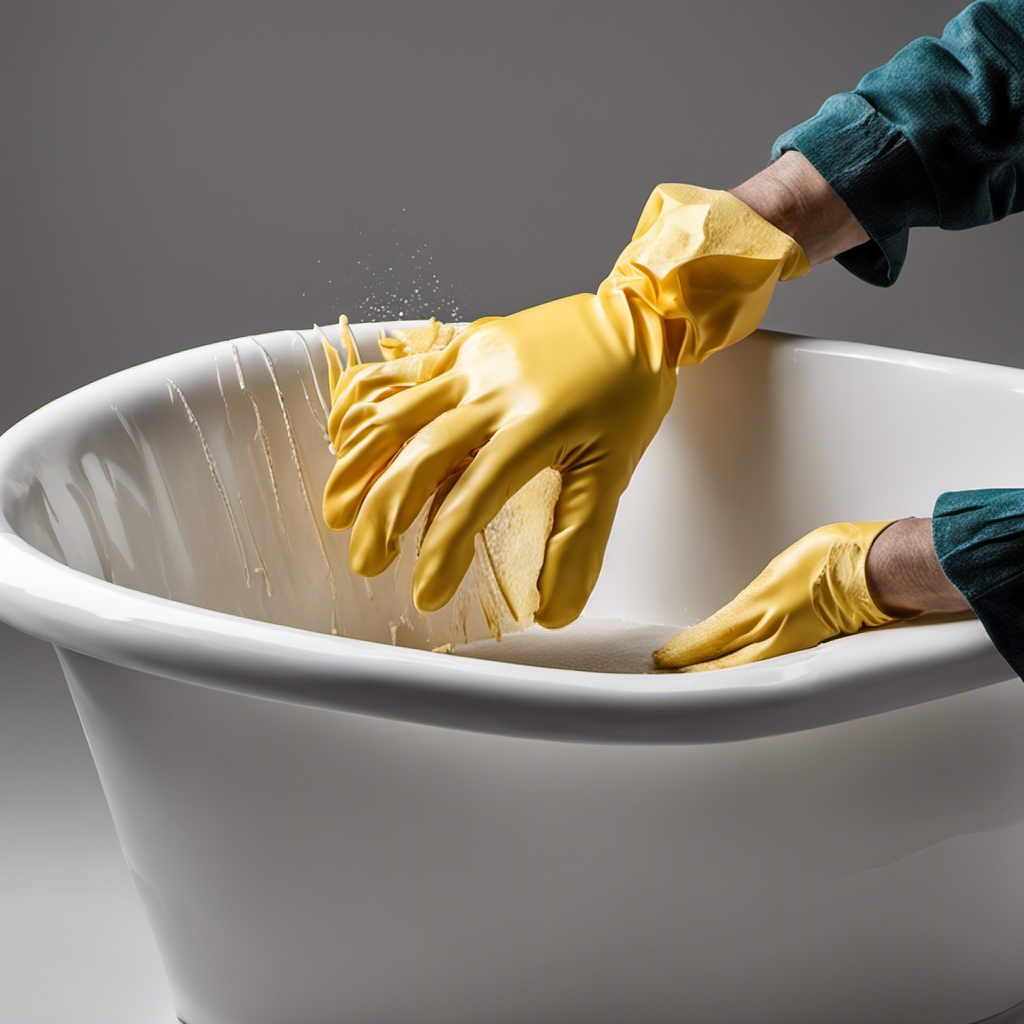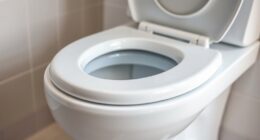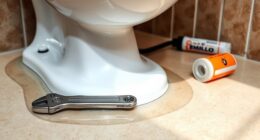Are you frustrated with your bathtub not draining properly? You’re not alone! Did you know that clogged bathtub drains are one of the most common plumbing issues homeowners face?
But fear not, because in this article, we will dive into the common causes of bathtub drain clogs, signs to look out for, and DIY methods to unclog your drain.
So, grab your plunger and get ready to say goodbye to that standing water in your tub!
Key Takeaways
- Hair buildup, soap scum and grease, foreign objects, and mineral deposits are common causes of bathtub drain clogs.
- Signs of a blocked bathtub drain include slow draining water, water pooling in the tub, gurgling sounds from the drain, foul odor from the drain, and backflow of water.
- DIY methods for unclogging a bathtub drain include using a mixture of baking soda and vinegar followed by hot water.
- It is advisable to call a professional plumber for drainage issues such as recurring clogs, foul odors, and slow draining water, as DIY methods may not provide a long-term solution.
Common Causes of Bathtub Drain Clogs
One of the most common causes of bathtub drain clogs is hair buildup. When you shower or bathe, it’s inevitable that some hair will go down the drain. Over time, this hair can accumulate and create a blockage.
It’s important to be aware of the warning signs to look out for, such as slow draining water or a complete backup. If you notice any of these signs, it’s crucial to address the issue promptly to prevent further damage.
To avoid this common mistake, consider using a drain cover or strainer to catch hair before it goes down the drain. Regularly cleaning and removing any hair buildup can also help prevent clogs.
Signs Your Bathtub Drain Is Blocked
If you’re experiencing a slow drain or water pooling in your tub, it could be a sign that your bathtub drain is blocked. Maintaining your bathtub drain is crucial in preventing blockages and ensuring proper drainage.
Regular maintenance includes simple steps that can save you from the hassle of dealing with a clogged drain. Start by removing any visible debris or hair from the drain using a pair of tweezers or a drain snake. Then, pour boiling water down the drain to help dissolve any accumulated soap scum or grease.
To prevent future blockages, consider using a drain cover to catch hair and other debris before it goes down the drain. If the blockage persists, it’s recommended to use a mixture of baking soda and vinegar, followed by hot water, to clear the blockage.
DIY Methods for Unclogging a Bathtub Drain
To clear a clogged bathtub drain, you can try using a mixture of baking soda and vinegar followed by hot water. This natural remedy is effective in breaking down the blockage and allowing water to flow freely again. Here are three simple steps to unclog your bathtub drain:
-
Start by pouring half a cup of baking soda into the drain. Make sure to distribute it evenly.
-
Next, pour half a cup of vinegar into the drain and immediately cover it with a drain plug or a cloth. This will create a chemical reaction that helps loosen the clog.
-
After about 30 minutes, remove the cover and pour boiling water down the drain to flush away the loosened debris.
No special tools are needed for this DIY method. Using baking soda, vinegar, and hot water is a cost-effective and eco-friendly way to unclog your bathtub drain.
When to Call a Professional Plumber for Drainage Issues
When it comes to drainage issues in your bathtub, it’s important to consider whether you should tackle the problem yourself or seek professional help.
While DIY methods can be cost-effective, they may not always provide a long-term solution.
Warning signs such as recurring clogs, foul odors, or slow draining water should be taken seriously as they could indicate more serious underlying issues that require the expertise of a professional plumber.
DIY Vs. Professional Help
You should consider whether you have the necessary skills and tools to fix the bathtub drain yourself or if it’s best to seek professional help. Here are some factors to consider when deciding between DIY and hiring a professional:
-
DIY vs. Professional Costs: DIY may seem cost-effective initially, but if you don’t have experience or the right tools, you might end up causing more damage and incurring higher repair costs. Hiring a professional ensures the job is done correctly the first time.
-
Pros of Hiring a Professional: Professionals have the expertise and experience to diagnose and fix complex drainage issues efficiently. They also have access to specialized tools and equipment, ensuring a thorough and long-lasting repair.
-
Cons of Hiring a Professional: The main drawback of hiring a professional is the cost. Professional services can be more expensive than doing it yourself. However, consider the value of your time and the potential risks associated with inadequate repairs.
Considering these factors, you can make an informed decision on whether to tackle the bathtub drain issue yourself or hire a professional. If you decide to proceed with DIY, be aware of warning signs that may indicate the need for professional help.
Warning Signs to Consider
One important warning sign to consider is if water is pooling around the drain instead of flowing smoothly. This could indicate a clogged drain or a problem with the plumbing system. If left untreated, it can lead to more serious issues, such as water damage or mold growth. If you are experiencing this problem and considering a bathroom renovation or bathtub replacement, it is crucial to address the drainage issue first. To help you understand the warning signs and potential causes better, here is a table outlining some common signs and their possible explanations:
| Warning Sign | Possible Cause |
|---|---|
| Water pooling around the drain | Clogged drain, plumbing issues |
| Slow draining | Partial blockage, buildup of debris |
| Gurgling sounds | Air trapped in the pipes, blockage |
| Foul odor | Bacterial growth, sewer line issue |
| Backflow of water | Clogged drain, plumbing issues |
How to Prevent Bathtub Drain Clogs
To keep your bathtub drain running smoothly, there are a few key points to keep in mind.
First, preventing hair clogs is crucial. Consider using a drain cover or trap to catch any hair before it goes down the drain.
Second, regular drain maintenance is essential. This includes periodically cleaning the drain with a mixture of baking soda and vinegar, as well as using a plunger to remove any blockages.
Lastly, be mindful of excessive soap usage, as soap scum can build up and contribute to clogs.
Hair Clog Prevention
If you don’t regularly clean your bathtub drain, hair can accumulate and cause clogs. Hair is one of the most common culprits of bathtub drain clogs, and it can easily build up over time if not properly addressed.
To prevent hair clogs and keep your drain flowing smoothly, here are three simple steps you can take:
-
Use a drain cover: Place a drain cover over your bathtub drain to catch hair and prevent it from going down the drain in the first place. This simple tool can significantly reduce the amount of hair that accumulates in your drain.
-
Clean the drain regularly: Make it a habit to clean your bathtub drain at least once a month. Use a drain snake or a bent wire hanger to remove any hair or debris that may have accumulated. This will help prevent clogs and keep your drain clear.
-
Use a drain cleaner: If you notice slow drainage or suspect a hair clog, you can use a drain cleaner specifically designed to dissolve hair. Follow the instructions on the product and use it as directed to clear the clog and restore proper drainage.
Regular Drain Maintenance
Make sure you clean your bathtub drain regularly to prevent hair clogs and maintain proper drainage. Regular drain maintenance is essential to keep your bathtub functioning properly and avoid any unpleasant surprises like a clogged drain. While there are some DIY methods you can try, it is important to recognize the importance of professional help in certain situations. Professional plumbers have the expertise and equipment to handle more complex drain issues and ensure that the problem is resolved effectively. Here is a visual representation of the benefits of regular drain maintenance and the importance of professional help:
| Regular Drain Maintenance | Importance of Professional Help |
|---|---|
| Prevents clogs | Expertise and equipment |
| Maintains proper drainage | Resolves complex issues effectively |
| Saves money in the long run | Ensures long-term solution |
| Reduces the risk of water damage | Provides professional advice |
| Promotes a clean and hygienic environment | Saves time and effort |
Avoiding Excessive Soap Usage
Using excessive soap can lead to clogged drains, so it’s important to be mindful of the amount you use while showering or bathing. Here are three reasons why you should avoid excessive soap usage:
-
Excessive soap residue: When you use more soap than necessary, it leaves behind a residue that can build up over time. This residue can accumulate in your drains, causing them to become clogged and preventing proper water flow.
-
Increased risk of clogs: The more soap you use, the greater the chance of clogs occurring. Clogs can be a hassle to deal with and may require the use of drain cleaning products to remove.
-
Best drain cleaning products: If you do encounter a clogged drain due to excessive soap usage, it’s important to have the right drain cleaning products on hand. Look for products specifically designed to dissolve soap scum and clear clogged drains effectively.
By understanding the impact of excessive soap usage on your drains, you can take steps to prevent clogs and ensure proper drainage.
Now, let’s explore the role of the p-trap in bathtub drainage.
Understanding the Role of the P-Trap in Bathtub Drainage
To understand why your bathtub is not draining, you should know that the P-trap plays a crucial role in maintaining proper drainage.
The P-trap is a curved pipe located under your bathtub that traps water and prevents sewer gases from entering your home. Its function is to create a water seal that blocks the passage of odors and gases. Without the P-trap, your bathtub would not have an effective barrier against these unpleasant smells.
Additionally, the P-trap also collects debris and prevents it from clogging your drain. Over time, hair, soap scum, and other particles can accumulate in the P-trap, leading to drainage issues.
Therefore, it is important to regularly clean and maintain your P-trap to ensure smooth and efficient bathtub drainage.
Alternative Solutions for Bathtub Drainage Problems
If your bathtub isn’t draining properly, you might want to consider trying out alternative solutions to solve the drainage problems. While calling professional plumbing services is always a good idea for severe issues, there are a few things you can try before resorting to that. Here are three alternative solutions that may help:
-
Use a plunger: Plungers can be effective in dislodging clogs that are closer to the surface. Make sure to cover the overflow drain with a damp cloth and create a tight seal around the drain before plunging.
-
Try a homemade drain cleaner: Mix equal parts of baking soda and vinegar and pour it down the drain. Let it sit for about 30 minutes, then flush it out with hot water. This can help break down mild clogs.
-
Consider a drain snake: A drain snake is a long, flexible tool that can reach deeper clogs. Insert it into the drain and rotate it to break apart the clog and pull it out.
Frequently Asked Questions
How Much Does It Cost to Hire a Professional Plumber for Bathtub Drainage Issues?
Hiring a professional plumber for bathtub drainage issues has its benefits. They can diagnose the problem accurately and provide a cost comparison of potential solutions. It’s wise to invest in their expertise to ensure a proper and efficient fix.
Can I Use Chemical Drain Cleaners to Unclog My Bathtub Drain?
If your bathtub is not draining, avoid using chemical drain cleaners as they can cause more harm than good. Instead, consider alternative solutions like using a plunger or a drain snake to clear the clog.
What Should I Do if None of the DIY Methods Work in Unclogging My Bathtub Drain?
If none of the DIY methods work in unclogging your bathtub drain, don’t worry. There are alternative solutions you can try, such as using a drain snake or a plunger. If all else fails, consider hiring professional plumbing services.
Are There Any Natural Remedies or Homemade Solutions for Unclogging a Bathtub Drain?
If your bathtub isn’t draining, don’t worry! There are natural remedies and homemade solutions to clear that clog. From baking soda and vinegar to using a plunger, you can easily fix the problem.
Can a Bathtub Drain Clog Be a Sign of a More Serious Plumbing Problem in the House?
If your bathtub drain is consistently clogging, it could be a sign of a more serious plumbing problem in your house. There are common causes for bathtub drain clogs that may require professional assistance.
Conclusion
In conclusion, if you find yourself asking, ‘Why is my bathtub not draining?’, there are several common causes and DIY methods you can try before calling a professional plumber.
By understanding the signs of a blocked drain and taking preventative measures, you can keep your bathtub free from clogs.
Remember, a clogged bathtub drain is like a roadblock on a busy highway, preventing water from flowing smoothly. So don’t ignore the issue and take action to keep your drainage system running smoothly.
